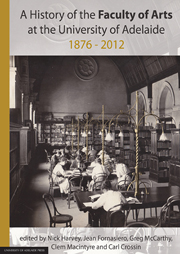Book contents
- Frontmatter
- Contents
- List of Contributors
- 1 The Faculty of Humanities and Social Sciences and the BA Degree at the University of Adelaide since 1876
- 2 Webs of Significance: an Ethnographer's Account of Anthropology at the University of Adelaide from 1973 to 2011
- 3 The History of the Centre for Asian Studies at the University of Adelaide
- 4 Classics at the University of Adelaide (1874–2012)
- 5 English and Creative Writing: ‘the abode of … literature; the home of poetry and fiction’
- 6 A Tale of Resilience: the History of Modern European Languages at the University of Adelaide
- 7 Geography, Environment and Population at the University of Adelaide, 1904–2012
- 8 Gender Studies and Social Analysis
- 9 History
- 10 The History of Aboriginal Languages and Linguistics at the University of Adelaide
- 11 The Digital, Participatory and International Turn: Media at the University of Adelaide
- 12 Musical fusions
- 13 Philosophy at the University of Adelaide
- 14 Politics at the University of Adelaide
- Appendices
1 - The Faculty of Humanities and Social Sciences and the BA Degree at the University of Adelaide since 1876
Published online by Cambridge University Press: 05 June 2013
- Frontmatter
- Contents
- List of Contributors
- 1 The Faculty of Humanities and Social Sciences and the BA Degree at the University of Adelaide since 1876
- 2 Webs of Significance: an Ethnographer's Account of Anthropology at the University of Adelaide from 1973 to 2011
- 3 The History of the Centre for Asian Studies at the University of Adelaide
- 4 Classics at the University of Adelaide (1874–2012)
- 5 English and Creative Writing: ‘the abode of … literature; the home of poetry and fiction’
- 6 A Tale of Resilience: the History of Modern European Languages at the University of Adelaide
- 7 Geography, Environment and Population at the University of Adelaide, 1904–2012
- 8 Gender Studies and Social Analysis
- 9 History
- 10 The History of Aboriginal Languages and Linguistics at the University of Adelaide
- 11 The Digital, Participatory and International Turn: Media at the University of Adelaide
- 12 Musical fusions
- 13 Philosophy at the University of Adelaide
- 14 Politics at the University of Adelaide
- Appendices
Summary
INTRODUCTION
The Bachelor of Arts (BA) was the first recognised degree at the University of Adelaide. Although informal classes for some subjects were held at the University between 1873 and 1875, official lectures began in 1876 with a curriculum comprising Humanities subjects that remain an integral part of the Arts degree in traditional universities, namely Philosophy, English and the classical languages. The Humanities provided the University's founding subjects because the BA was the only degree offered in the first eight years of the University's existence. The BA began to adopt a wider brief of basic scientific knowledge through additional courses in Physics, Chemistry and Biology but this changed in 1882, when the Bachelor of Science (BSc) was added to the curriculum and the natural sciences were transferred from the BA to the BSc. In response the BA imposed a new and compulsory curriculum, comprising Latin, Greek, Mathematics, Natural Philosophy, Logic, English, History, and Comparative Philology.
Even though the first graduate of the University was awarded a BA degree in 1879, it was not until eight years later, in 1887, that the Faculty of Arts was inaugurated. At the same time, modern languages, such as French and German, were formally added to the range of subjects. In 1897, the Elder Conservatorium of Music was created as the first music school of its type in Australia, although at that time it was not part of the Faculty of Arts. Within the first two decades, many of the major components of what would eventually become the Faculty of Humanities and Social Sciences were already in place.
- Type
- Chapter
- Information
- A History of the Faculty of Arts at the University of Adelaide1876-2012, pp. 1 - 22Publisher: The University of Adelaide PressPrint publication year: 2012
- 1
- Cited by



